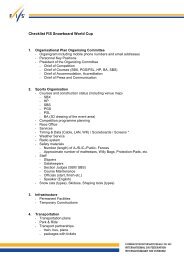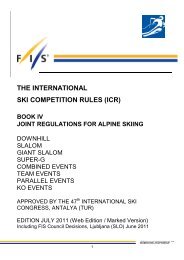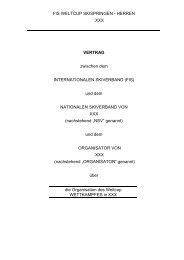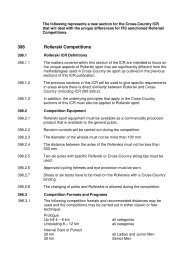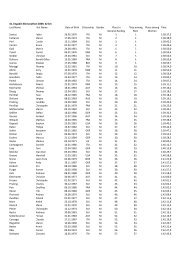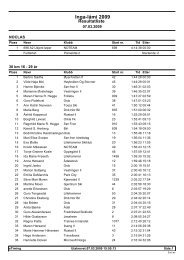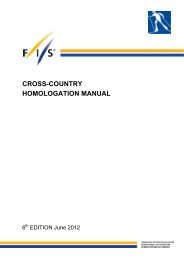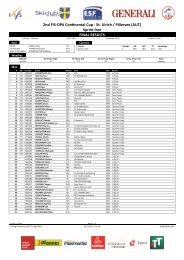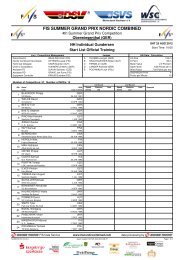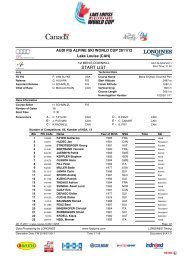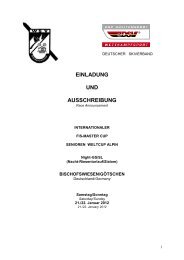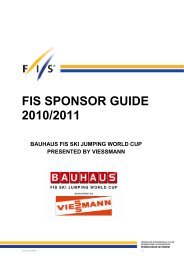THE INTERNATIONAL SKI COMPETITION RULES (ICR)
THE INTERNATIONAL SKI COMPETITION RULES (ICR)
THE INTERNATIONAL SKI COMPETITION RULES (ICR)
You also want an ePaper? Increase the reach of your titles
YUMPU automatically turns print PDFs into web optimized ePapers that Google loves.
designated system A (main system), the other system B (back up system)<br />
prior to the beginning of the race.<br />
All time of day times must be immediately and automatically sequentially<br />
recorded on printed strips to at least the 1/1000th (0.001) precision. Both<br />
systems must allow for the calculation of net times by the mathematical<br />
comparison of each racer’s start time to finish time. The final result for<br />
each skier’s run is then expressed to 1/100th (0.01) precision by<br />
truncating the calculated net time on course.<br />
All times used for the final result must be from system A. If there is a<br />
failure of system A a calculated net time from system B must be used<br />
following the same procedure as set out in 611.3.2.1. It is not permitted to<br />
substitute time-of-day times from system B for use with system A for the<br />
purpose of net time calculations.<br />
For all events, system A must be connected to its respective start gate<br />
contact. System B must be separately connected to another electronically<br />
isolated start gate contact.<br />
Refer to the FIS Timing Booklet for more details regarding cabling and<br />
complete wiring descriptions, diagrams and start gate installations.<br />
All timing equipment and technical installation should be set up or<br />
protected in such a way that danger to the competitors is avoided where<br />
possible.<br />
Synchronisation of the timing systems must occur within 60 minutes of the<br />
start of each run. Synchronisation of all systems must be maintained<br />
throughout each run. Timers must not be re-synchronised during any run.<br />
611.2.1.1 Start Gate<br />
The start gate must have separate electronically isolated switch contacts<br />
for triggering the start inputs of both system A & B.<br />
If a start gate or start wand requires replacement during a run, it must<br />
replaced with identical equipment in the same position<br />
611.2.1.2 Photocells<br />
For all events, there must be two photocell system(s) homologated by the<br />
FIS installed at the finish line. One is connected to system A. The other is<br />
connected to system B.<br />
Procedures and regulations for start gates and photocells are found in the<br />
FIS Timing Booklet.<br />
611.2.1.3 Start Clock<br />
For DH, SG and GS, the use of a start clock that provides at least an<br />
acoustic countdown signal on the fixed start interval as prescribed by the<br />
Jury should be used as an aid to race management. This is mandatory for<br />
all Level 0,1 and 2 races.<br />
611.2.2 Hand Timing<br />
Manual (hand) timing, completely separate and independent of the<br />
electronic timing, must be used for all competitions listed in the FIS<br />
Calendar. Stopwatches or hand operated battery powered timers that are<br />
installed at both the start and the finish and capable of expressing times<br />
to at least 1/100th (0.01) precision qualify as proper hand timing devices.<br />
They must be synchronised prior to the start of each run, preferably with<br />
51



